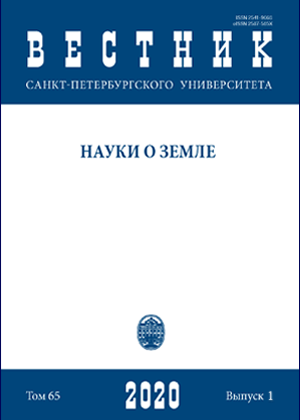Simulation of the shielding properties of environmental components against the external radioactive radiation from the Ordovician Dictyonema shale
DOI:
https://doi.org/10.21638/spbu07.2020.101Abstract
This paper presents the results of simulating the conditions of absorption of natural radionuclides (uranium-238, thorium-232, potassium-40) in different environment media (water and quartz sand) to assess the effect of the shielding properties of environmental components on the intensity of external radiation exposure to the benthic biota. The source of radiation was the lower Tremadocian Dictyonema shale, which formed the bottom of the Baltic Paleobasin. Water and quartz sand, which was gradually deposited on the roof of the Dictyonema shale, were used in the simulation as media (materials) absorbing the primary radiation. The manuscript shows an experiment conducted in full-scale conditions considering a single exposure of a section of Ordovician rocks that includes highly radioactive Dictyonema shale. This is a small area, but the simulation results are also valid for larger areas as the Baltic Paleobasin. During the late Tremadocian — Floian, along with transgression, benthic biota began to emerge. The experiment shows quantitatively what dosage this biota could have experienced over tens and hundreds of thousands of years, until the Dictyonema shale was covered with a sufficiently thick layer of water-flooded sediments. Experimental data show that the presence of a 10 cm thick layer of water reaches absorption of 40 % of the integral flux of all gamma lines of natural radionuclides (NRN), and in a moist quartz sand layer of the same thickness the absorption value does not exceed 50 %. Thus, despite the screening effect of the environment, the benthic biota of Baltoscandia in the Early Ordovician could have been under significant radiation exposure for millennia. The main value of the experiment is that it was performed in situ, and exclusively natural media were used as modelling elements.
Keywords:
Dictyonema shale, natural radionuclides, gamma radiation, absorption coefficient, radiation shielding properties, benthic biota
Downloads
References
Downloads
Published
How to Cite
Issue
Section
License
Articles of "Vestnik of Saint Petersburg University. Earth Sciences" are open access distributed under the terms of the License Agreement with Saint Petersburg State University, which permits to the authors unrestricted distribution and self-archiving free of charge.






